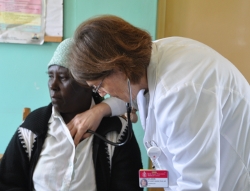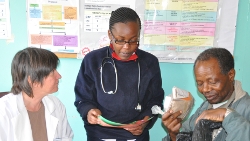- Home
- The Manning College
- Scholarships: Beacons of Promise
- Partnerships
- Global Health
- Kenya Heart And Sole The Afya Njema Project
- Cardiovascular Disease In Africa
Cardiovascular Disease in Africa
The prevalence of hypertension (HTN) in Sub-Saharan Africa is rising rapidly. Recent estimates from the World Health Organization (WHO) indicate that HTN is a leading cause of premature morbidity and mortality, and that prevention and control could prevent at least 250,000 deaths annually; however, estimates of awareness (40%), treatment (30%) and control (20%) are low (WHO, 2009). Clustering of risk factors with increased risk of CVD morbidity/mortality is also rising, leading to increased disease burden.

|
| Dr. Eileen Stuart-Shor, NP and cardiovascular specialist, assessing a patient during the 2011 health screening and treatment. |
In April of 2010, a report released by the Institute of Medicine titled “Promoting Cardiovascular Health in the Developing World: A Critical Challenge to Achieve Global Health" reaffirmed the importance of the work we do in Kenya. The report notes, as we have in previous reports, that while the behaviors needed to reduce cardiovascular risk factors (eating healthy, being active, avoiding tobacco, and seeking regular health care) appear simple, understanding how to adapt this for a different continent is a far more complex job. In communities in both urban and rural Kenya, socioeconomic and environmental factors prevent people from getting access to quality medical care, and lifestyles are drastically different. In addition, we have found that simply blaming the increase in cardiovascular/metabolic disease on increased westernization is overly simplistic. Clearly, this shows the need to develop a specifically Kenyan cardiovascular disease management model.
To be comprehensive, a cardiovascular disease prevention and control program must integrate policies designed to foster a societal environment in which people are encouraged to make and maintain healthy living choices, and provide health services focused on early detection and cost-effective strategies (Hunter, D. & Reddy, K., 2013).
Data gathered over the last five years by the Kenya Heart and Sole team indicate that one common CV risk factor, unhealthy eating habits including low consumption of fruits and vegetables and the use of solid, saturated fat for cooking, are common in Kenya, while other CV risk factors including sedentary lifestyle, smoking, and excessive consumption of soda and processed foods were not observed. This seems to suggest that standard risk factors for CVD/diabetes in the western world –– do not entirely explain the CV risk factor profile in Kenya. Despite that, the individuals that we screened had a greater than average rate of CV/Metabolic conditions including hypertension, diabetes and obesity and consistently exhibited a high clustering of CV/metabolic risk factors. Clinicians need to work within the communities themselves to develop effective, culturally-relevant programs to combat the rise of cardiovascular disease in Sub-Saharan Africa.
More research must be done to understand what leads to these chronic conditions in Sub-Saharan Africa and to tailor interventions that are culturally relevant. (KHAS Abstracts are posted in the link to the left)

|
| UMass Boston NP master’s student, Monica, works with her Kenyan partner to treat a triaged client. |
The Institute of Medicine and World Health Organization has called on the world’s clinicians and researchers to exercise leadership and advocacy for chronic diseases, to build evidence-based and locally relevant solutions, to assess what works and disseminate innovation, to promote solutions through collaboration, and to work towards global progress. We have been working towards these goals for several years now. The purpose of Kenya Heart and Sole: The Afya Njema Project is to work in partnership with our Kenyan colleagues to improve cardiovascular health through the development of a feasible, sustainable, and culturally relevant CV/metabolic risk reduction program that emphasizes community engagement and self-management. Throughout the narrative of our trip and blog, you will read about our work with our partners, the importance of collaboration, and the power of each individual to make a difference. Our work is focused on population health solutions, but populations are made up of individuals. The Kenyans we cared for were touched by what we did; our lives were transformed by what we saw. We returned enriched, energized and humbled by the journey.
References:
Institute of Medicine, (2010). Promoting Cardiovascular Health in the Developing World. Retrieved from: http://www.ncbi.nlm.nih.gov/books/NBK45693/pdf/TOC.pdf
World Health Organization (2009). Global health risks: Mortality and burden of disease attributable to selected major risks. Retrieved from https://apps.who.int/iris/bitstream/handle/10665/44203/9789241563871_eng.pdf
Hunter, D. & Reddy, K. (2013). Noncommunicable diseases. New England Journal of Medicine. Retrieved from: http://www.nejm.org/doi/full/10.1056/NEJMra1109345